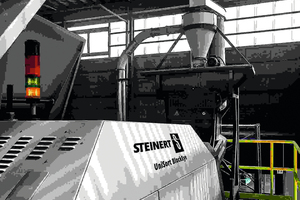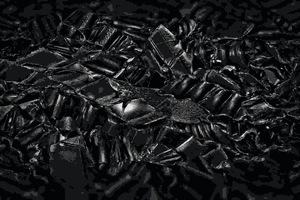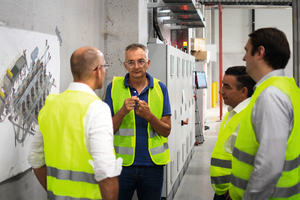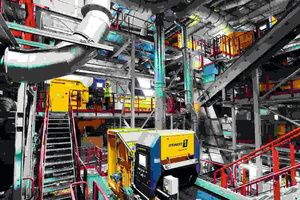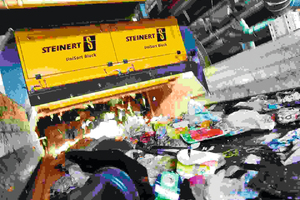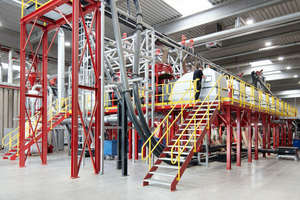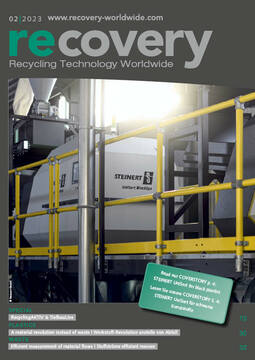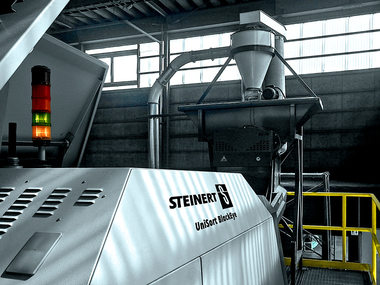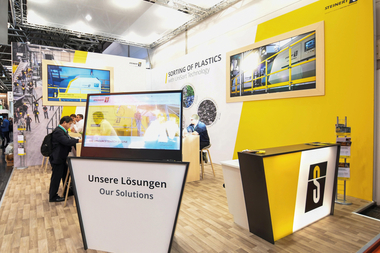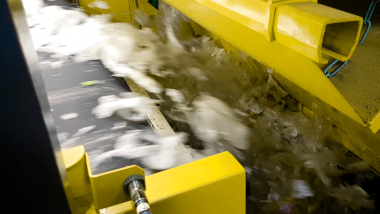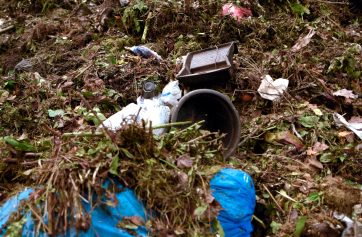STEINERT UniSort sorting technology for black plastics
Everyone involved in the plastics industry is concerned with strict legislation and a social sense of responsibility for recovering plastics. Black plastics represent a particular challenge because they cannot be detected with the optical sorting technology found in standard recycling plants. STEINERT technology allows black plastics to be sorted from the general waste stream and to be sorted into pure grades. This enables partners of the sorting specialist to respond to the new challenges of the circular economy in a cost-effective manner and to be equipped for all the processes involved in plastic recovery and processing in equal measure.
Near-infrared (NIR) technology is used in recycling plants to identify plastics which can be recycled. Here, optical sensors use light reflection to register the material and separate it accordingly into its valuable fractions. However, the black colouring of dark plastic packaging means that the light reflection is reduced to a minimum, such that the packaging cannot be correctly identified or sorted by standard optical sensors.
STEINERT technology has been able to sort black plastics since 2014
STEINERT has spent years working on detection for highly demanding sorting applications. The launch of the UniSort PR saw the adoption of what is known as Hyper Spectral Imaging (HSI) technology, which is superseding the point-to-point scanners previously usually used and, thanks to its finer resolution, is able to cover 256 rather than just 16 measuring points in the spectrum. It is able to evaluate even the slightest differences in the chemical composition of the materials awaiting detection. Back in 2014, STEINERT was the first company to be able to detect and therefore positively sort out black plastics with the aid of the UniSort Black. This improved recycling rates and reduced the residual fractions going to incineration.
In 2015, STEINERT launched UniSort Film, a conveyor technology for high-performance 2D sorting with a belt speed of 4.5 m/s. Together with UniSort Black, this is still today the only machine available for sorting black films. At the same time, initial testing was underway of the UniSort BlackEye, the world’s first machine for pure-grade detection and sorting of black PE and PP plastics. It has been used around the globe since 2016. UniSort BlackEye is therefore the most recent iteration of STEINERT’s HSI technology, which it has been consistently refining since 2011.
New life for black plastics with
STEINERT technology
STEINERT GmbH was recently able to implement a perfect application project. The GRAF Group has committed itself to taking a responsible approach to nature. For 60 years, this Baden-based family business has been producing plastic products for the sustainable use of rainwater. Some 70 % of the material in GRAF products is recycled, thanks to the company‘s convictions. GRAF began back in 1980 by producing the first water barrel in recycled plastic. To increase the recycling rate still further, GRAF has opted for STEINERT sorting machines for difficult-to-sort plastics which will return this supposedly residual fraction to the recycling economy. “Our objective is to be using 95 % secondary raw materials in our products in five years‘ time,” says Jörg Drägert, head of raw materials management at GRAF.
In 2017 GRAF received confirmation of funding from the environmental initiative programme offered by the German Federal Ministry for the Environment, Nature Conservation, Nuclear Safety and Consumer Protection. GRAF had demonstrated that sorting material fractions that were previously considered low-value, and usually exploited thermally or recycled as mixed plastics, could work and that these materials could be upgraded to high-quality recycled plastics. The focus here is on black plastics. Conventional optical sorting systems cannot detect these plastics, which thus pose a seemingly unsolvable task for recyclers. But GRAF succeeded at the challenge, and it is proud of that.
STEINERT sorting machines for
difficult-to-sort plastics
The sorting process is made possible by STEINERT technology, which not only positively separates black plastics but can also sort them accurately. A total of 16 UniSort sorting machines with hyperspectral imaging (HSI) sensors are in use at the GRAF raw materials competence centre in Herbolzheim, where they generate PP and HDPE fractions in black and light for subsequent regranulation. Key here, along with the UniSort Black, are the UniSort Finealyse and UniSort BlackEye sorting machines, which are optimised for sorting small grain sizes.
Using near-infrared (NIR) sensors and a colour camera, UniSort Finealyse can sort plastic flakes by type and colour. A high-speed belt together with a directed air stream stabilise even the smallest objects for the best possible quality levels with minimal excessive sorting. The UniSort BlackEye is based on the same design. It features a sensor for the middle-infrared (MIR) frequency range. This allows black polyolefins (PO) to be accurately sorted into their constituent parts, such as polyethylene (PE) and polypropylene (PP), but also polystyrene (PS) and acrylonitrile butadiene styrene copolymers (ABS).
The recycling economy – conceived from start to finish
Perfectly matched processes ultimately enable GRAF to provide warranties on its products of up to 30 years. And it doesn‘t stop there. “We‘re particularly proud of our superior products, for which the next loop has already been thought through”, since all GRAF products can be subsequently recycled. “We‘re experts in the circular economy. It‘s just as right for water as it is for plastics. Both of these are hugely important issues for the future.”
Recyclers of the world, unite!
Each year 350 million tonnes of new plastics are brought into circulation and pose immense challenges at an international level. To achieve the objectives it has set itself, GRAF is continuing to diversify and to invest in new cooperations. “Unfortunately, too many sorters still don‘t know that black plastics can be separated. There‘s a solution for it!” With STEINERT sorting machines, these plastics fractions can be recovered in post-consumer packaging sorting plants and then recycled in cooperation with GRAF. “How often can you buy a technology and gain a customer for it at the same time?”
Turning plastic waste into new goods –
thanks to pure-grade separation
Plastic-processing companies in particular can benefit from STEINERT products and replace polymer granulates with mint-condition recyclates. Even black polyolefins (PO), which are hard to recycle, can be sorted into their fractions, such as polyethylene (PE) and polypropylene (PP), but also polystyrene (PS) and acrylonitrile butadiene styrene copolymers (ABS), to a level of quality approaching primary plastics.
UniSort BlackEye therefore allows plastic waste containing a high proportion of black to be separated at big industry level and then to be upgraded to a plastic granulate with properties similar to those of the primary raw material in order for it to be used to manufacture durable quality products. This procedure means that a significant percentage of new plastics can be replaced with recycled materials today, thereby saving hundreds of thousands of tons of CO2 every year.
A key role in this progress was played by STEINERT’s UniSort series, the UniSort Black variant of which is able to separate not only materials which can be detected using near-infrared (NIR) technology, but also dark and black objects, which increases recycling rates and therefore significantly reduces the residual fraction going to incineration. The innovative UniSort Film conveyor technology was also used to detect and sort 2D objects. Because these objects tend to float up off the belt at higher belt speeds, clever air flow technology on the belt and in the hood provides a solution, allowing flat and lightweight materials to be sorted in a cost-effective way for the first time.
A successful combination, as STEINERT customers like Christian Hündgen, Managing Director of Hündgen Entsorgungs GmbH & Co. KG praise: „Both technologies have been developed by STEINERT and implementing them has enabled us to offer a better sorting depth and achieve better results. At the same time of course this also improves our product quality. On a personal level this project has been a complete success and it has been recognised as a highly resource-efficient project by the Resource NRW Initiative“.
But new technologies don’t just increase the cost-effectiveness of sorting plants by improving recycling rates but also by offering improved maintenance. In particular, the interaction between dynamic calibration and the automatic white balance in the STEINERT UniSort series makes for great ease of sorting coupled with excellent ease of maintenance, ensuring that the technology is available at all times. 95 % of plant adjustments are undertaken by means of remote maintenance and regular software updates guarantee performance and process reliability a high level of adaptability at all times.

